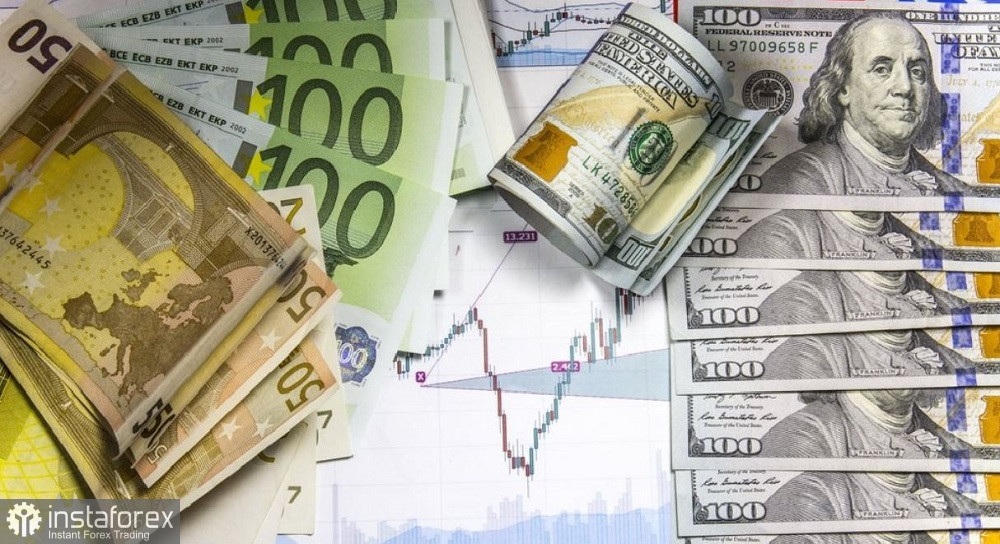The EUR/USD pair attempted to develop a corrective movement at the start of the new trading week. However, the U.S. dollar index continues to hold steady, making it challenging for buyers of the pair to impose their game. During Monday's European session, the pair dipped below the 1.0900 level again.
The risk-off sentiment still dominates the market. Today, there is reduced interest in risk following reports that S&P Global has lowered its GDP growth forecast for China this year from 5.5% to 5.2%. Against this backdrop, U.S. stock index futures are trading lower, while the U.S. dollar is attempting to regain its position despite starting the week with a downward gap.
However, all of this is just a prelude: the main events of this week will unfold a little later, specifically from Wednesday, when central bank heads from leading countries around the world will speak at the ECB Forum in Sintra, Portugal. Additionally, important macroeconomic reports are expected in the second half of the week, such as the growth of the PCE index in the U.S. and the consumer price index in Germany and the eurozone.

So, during a panel discussion at the annual ECB Forum in Sintra on Wednesday, ECB President Christine Lagarde and Fed Chairman Jerome Powell will be among the speakers. In my opinion, EUR/USD traders' attention will be on the rhetoric of the ECB President since the Federal Reserve Chairman has already expressed his position several times over the past two weeks, including at the press conference following the June meeting and twice in Congress. Therefore, he is unlikely to give market participants any verbal surprise.
The prospects for tightening the Fed's monetary policy are relatively clear. The central bank is almost certain to raise rates at one of the upcoming meetings (probably as early as next month) and possibly one more time by the end of the year (in the event of accelerated inflation). This disposition aligns with market expectations. According to the CME FedWatch Tool, the probability of a rate hike in July stands at 72%. The probability of maintaining the status quo at the next meeting, assuming a rate hike in July, is 66%. If Powell does not disrupt this predictive framework on Wednesday, the market reaction may be minimal. The dollar may receive situational support, but nothing more.
On the other hand, Lagarde may strengthen the euro's position. The ECB President has recently noticeably tightened the tone of her rhetoric, and there are currently no objective reasons for her to soften it. I would like to remind you that following the June meeting, Lagarde effectively announced a rate hike in July and stated the need to "move forward." Furthermore, she reiterated that rates will be kept at the achieved level "for as long as needed." Given Lagarde's rhetoric over the past few weeks, it can be assumed that she will also voice hawkish statements on Wednesday, providing support to the euro.
It is noteworthy that Powell and Lagarde will be speaking on the eve of important inflation releases.
On Thursday, June 29, data on German inflation growth will be published. Acceleration of key indicators is expected here. The overall consumer price index in annual terms should reach 6.3% (previous value was 6.1%). The harmonized CPI should demonstrate a similar trend (rise to 6.7% from the previous value of 6.3%). If the report comes out at the forecasted level (not to mention the "green zone"), it will be a "cause for concern" for EUR/USD sellers since German inflation correlates with the dynamics of the overall European CPI.
The report on inflation growth in the Eurozone will be published the next day, Friday. According to the forecasts of the majority of experts, the overall consumer price index should decrease significantly to 5.6% (from the May value of 6.1%). However, the core CPI, excluding energy and food prices, should demonstrate an upward trend, rising to 5.5% from the previous value of 5.3%. In this case, all attention will be focused on core inflation, while the decrease in the overall CPI will have secondary importance.
Important inflation data will also be published in the United States. Thus, on the last trading day of the week, we will learn about the dynamics of the most favored inflation indicator by the Federal Reserve—the Personal Consumption Expenditures (PCE) index. According to forecasts, the indicator will remain at the level of the previous month (April), that is, at 4.7%. Any deviations from the projected scenario will accordingly affect the positions of the greenback. Although the PCE index will not shake confidence in the July rate hike, its dynamics can strengthen/weaken market confidence in the Fed's further actions regarding monetary tightening.
Thus, "hot days" await us, but the main price "swings" are likely to start from the middle of the week. Theoretically, Christine Lagarde, with her hawkish rhetoric, is capable of reversing the trend and bringing EUR/USD buyers back to life, but her words must be supported by inflation. Judging by preliminary forecasts regarding the pace of CPI growth in Germany and the Eurozone as a whole, such a scenario is quite likely. Jerome Powell, in turn, has already said his word and is unlikely to surprise market participants with verbal interventions.
From a technical point of view, the EUR/USD pair on the daily chart remains within the Kumo cloud, above the Tenkan-sen and Kijun-sen lines, and between the middle and upper lines of the Bollinger Bands indicator. Considering long positions is advisable only after buyers return to the 9th figure area, specifically overcoming the target of 1.0940 (upper border of the Kumo cloud on D1). In this case, the Ichimoku indicator will form a bullish "Parade of Lines" signal. In such a scenario, the initial and current main target of the upward movement will be the level of 1.1010 (upper line of the Bollinger Bands indicator on the four-hour chart).





















